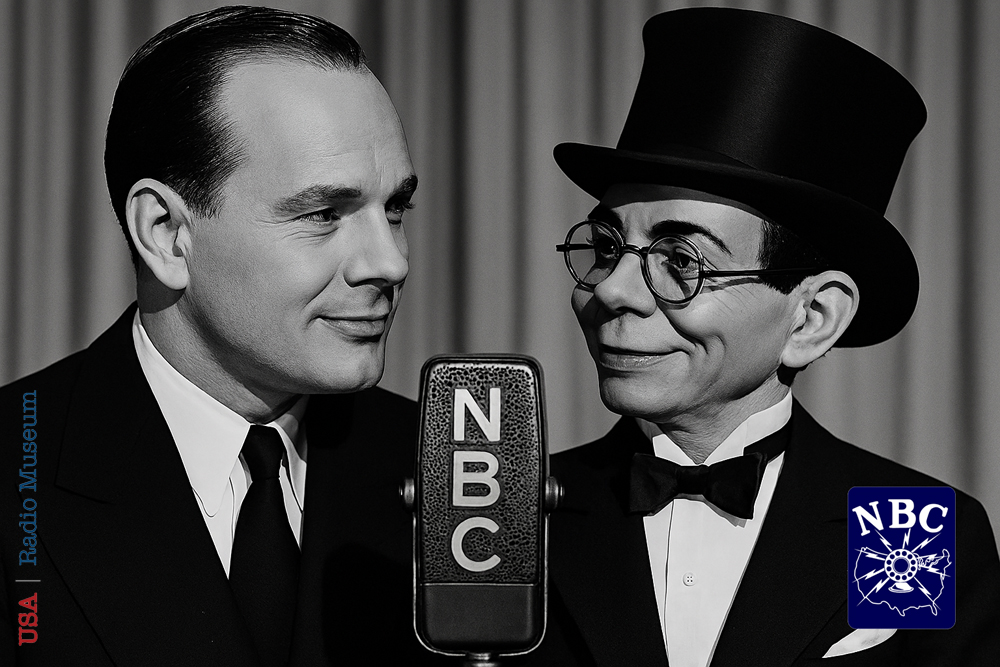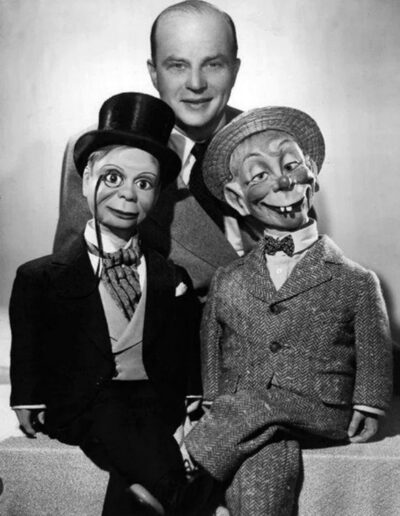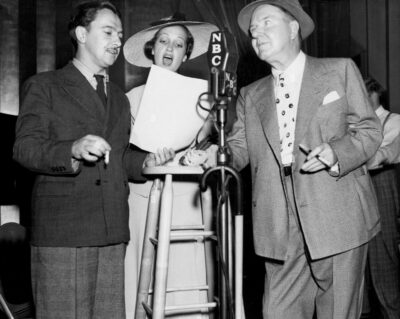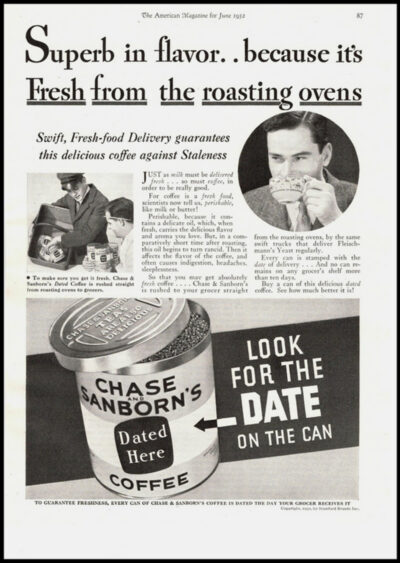The Chase and Sanborn Hour: America’s Sunday Night Spectacle Introduction: A Nation Tuned In Before television flickered into American homes, ra
The Chase and Sanborn Hour: America’s Sunday Night Spectacle
Introduction: A Nation Tuned In
 Before television flickered into American homes, radio was the hearth—and on Sunday nights, it was The Chase and Sanborn Hour that lit the fire. From the early 1930s through the end of the 1940s, this variety broadcast was more than entertainment; it was ritual. Families gathered around their Philco sets, the aroma of Sunday supper still lingering, as the familiar jingle of Chase and Sanborn coffee signaled the start of an hour that promised laughter, music, and a parade of stars.
Before television flickered into American homes, radio was the hearth—and on Sunday nights, it was The Chase and Sanborn Hour that lit the fire. From the early 1930s through the end of the 1940s, this variety broadcast was more than entertainment; it was ritual. Families gathered around their Philco sets, the aroma of Sunday supper still lingering, as the familiar jingle of Chase and Sanborn coffee signaled the start of an hour that promised laughter, music, and a parade of stars.
In an era when the spoken word carried the weight of imagination, The Chase and Sanborn Hour mastered the art of auditory spectacle. It was a show that evolved with the times—beginning as a modest musical program, then transforming into a comedic juggernaut that helped define the variety format. Anchored by legendary performers like Eddie Cantor and Edgar Bergen (with his famously wooden sidekick, Charlie McCarthy), the broadcast became a showcase for Hollywood royalty and a proving ground for radio innovation.
But its magic wasn’t just in the marquee names. It was in the timing of a punchline, the chemistry between performers, the way Bergen’s ventriloquism somehow worked through sound alone. It was in the shared laughter of millions, coast to coast, who tuned in not just for entertainment, but for connection.
When The Chase and Sanborn Hour first crackled across NBC’s Red Network in 1937, it didn’t just entertain—it transformed Sunday nights into a national ritual of laughter, wit, and wonder. At the heart of this phenomenon was Edgar Bergen, the master ventriloquist whose wooden sidekick, Charlie McCarthy, became a household name. With Charlie’s monocled sass and Bergen’s understated brilliance, the duo redefined radio comedy, drawing millions of listeners into their world of playful banter, celebrity guests, and cultural satire. This was more than a program—it was a mirror to America’s mood, a soundtrack to its smiles, and a cornerstone of its broadcast identity.
This article revisits the full arc of The Chase and Sanborn Hour—from its humble beginnings to its cultural crescendo, from the controversies it courted to the legacy it left behind. It’s a tribute to a show that didn’t just fill an hour—it filled a generation with joy. —USA Radio Museum
_____________________
Origins and Evolution (1929–1937)
 The story of The Chase and Sanborn Hour begins not with comedy, but with music. In 1929, the program debuted as The Chase and Sanborn Choral Orchestra, a half-hour showcase of orchestral arrangements and vocal performances, designed to promote its namesake sponsor—Chase and Sanborn Coffee. At the time, radio was still finding its rhythm, and advertisers were quickly learning that entertainment was the most persuasive form of persuasion.
The story of The Chase and Sanborn Hour begins not with comedy, but with music. In 1929, the program debuted as The Chase and Sanborn Choral Orchestra, a half-hour showcase of orchestral arrangements and vocal performances, designed to promote its namesake sponsor—Chase and Sanborn Coffee. At the time, radio was still finding its rhythm, and advertisers were quickly learning that entertainment was the most persuasive form of persuasion.
NBC, eager to build prestige around its Sunday night lineup, positioned the show as a refined musical offering. But by 1931, the network sensed a shift in audience appetite. The Great Depression had cast a long shadow over American life, and listeners craved levity, escape, and personality. Enter Eddie Cantor.
Cantor, already a vaudeville and Broadway sensation, brought a kinetic energy to the program that transformed it overnight. With his rapid-fire delivery, self-deprecating humor, and knack for topical jokes, Cantor turned the show into a comedic variety hour that resonated with millions. He sang, he joked, he bantered with guest stars—and he did it all with a wink that made listeners feel like insiders.
Under Cantor’s stewardship, The Chase and Sanborn Hour became a ratings powerhouse. His segments often included playful jabs at politicians, celebrities, and even the sponsor itself, which only endeared him more to the public. But Cantor’s boldness also courted controversy. His jokes occasionally pushed boundaries, and his outspoken support for political causes—particularly his criticism of fascism and anti-Semitism—made him a lightning rod in an increasingly polarized media landscape.
Despite the friction, Cantor’s tenure from 1931 to 1934 laid the foundation for what the show would become: a dynamic blend of comedy, music, and star power. It was no longer just a coffee-sponsored broadcast—it was a cultural event. And as Cantor stepped away, the show was poised for its next evolution, one that would introduce a ventriloquist and his wooden companion to an audience ready to believe in anything.
Chase and Sanborn Hour (Episode #01) | Edgar Bergen & Charlie McCarthy | May 9, 1937
Audio Digitally Remastered by USA Radio Museum | NOTE: The episode that changed everything. Edgar Bergen and Charlie McCarthy make their first appearance, instantly captivating audiences with their banter and charm. A historic turning point in radio comedy.
The Bergen & McCarthy Era (1937–1948): Ventriloquism Meets Mass Media
When Edgar Bergen and Charlie McCarthy joined The Chase and Sanborn Hour in May of 1937, they didn’t just add a new act—they redefined what radio could be. Bergen, a soft-spoken ventriloquist with a sharp wit, and McCarthy, his monocled, top-hatted dummy with a mischievous streak, became the most unlikely stars of the airwaves. In a medium built on sound alone, they made ventriloquism not just viable, but wildly popular.
It was a paradox that delighted listeners: a wooden dummy who couldn’t be seen, yet whose personality was so vivid he seemed more alive than many of the show’s human guests. McCarthy was irreverent, flirtatious, and unfiltered—a perfect foil to Bergen’s straight-man persona. Their banter was fast, clever, and often laced with double entendres that danced just beyond the reach of censors.
The chemistry was electric. Bergen’s timing was impeccable, and McCarthy’s voice—nasal, bratty, and aristocratic—became instantly recognizable. Their routines often revolved around McCarthy’s romantic escapades, his disdain for authority, and his playful insults aimed at guest stars. It was comedy with character, and it resonated deeply with Depression-era and wartime audiences who craved both laughter and familiarity.
One of the most infamous moments in the show’s history came in December 1937, when actress Mae West appeared in a sketch with Bergen and McCarthy. The segment, a risqué parody of the Garden of Eden, featured West as Eve and McCarthy as a very forward Adam. The dialogue was suggestive, the chemistry undeniable—and the backlash swift. The FCC received a flood of complaints, and West was banned from NBC radio for 10 years. The controversy only heightened the show’s allure, cementing its reputation as daring and unpredictable.
Chase and Sanborn Hour (Episode #32) | Edgar Bergen & Charlie McCarthy | December 12, 1937
Audio Digitally Remastered by USA Radio Museum | NOTE: Infamous and unforgettable. Mae West’s sultry repartee with McCarthy led to FCC backlash and a temporary ban from NBC. A moment that tested the boundaries of radio’s moral compass.
Throughout the late 1930s and into the 1940s, Bergen and McCarthy were the show’s beating heart. Their segments often overshadowed the musical performances and guest appearances, and they became cultural icons in their own right. McCarthy dolls flew off shelves, fan clubs sprang up, and the duo graced magazine covers and newsreels. They even made the leap to film, starring in several movies that capitalized on their radio fame.
Behind the scenes, Bergen was meticulous. He wrote much of the material himself, refining McCarthy’s voice and persona with the precision of a playwright. He understood that McCarthy wasn’t just a dummy—he was a character with depth, contradictions, and charm. And audiences responded with devotion.
As the 1940s progressed, the show’s format shifted. It was shortened to a half-hour, retitled The Chase and Sanborn Program, and occasionally went on summer hiatus. But Bergen and McCarthy remained the centerpiece, adapting their routines to fit the changing times. They joked about wartime rationing, Hollywood gossip, and postwar optimism, always keeping a finger on the pulse of American life.
Chase and Sanborn Hour (Episode #223) | Edgar Bergen & Charlie McCarthy | December 7, 1941
Audio Digitally Remastered by USA Radio Museum | NOTE: Guests: Judy Garland and Abbott & Costello
By the time the show ended in 1948, Bergen and McCarthy had become legends. Their success proved that radio wasn’t just about voices—it was about imagination. They invited listeners to believe in the impossible: that a dummy could be charming, that a ventriloquist could vanish behind his creation, and that laughter could be shared across millions of homes, all at once.
Star Power and Guest Appearances
If The Chase and Sanborn Hour was the stage, then Hollywood was its guest list. Throughout its run, the show became a magnet for the biggest names in entertainment—actors, singers, comedians, and personalities who saw radio not just as promotion, but as performance. It was a place where Clark Gable could trade quips with Charlie McCarthy, where Bette Davis could reveal her comedic side, and where Marlene Dietrich’s sultry voice could captivate without ever being seen.
The guest appearances were more than cameos—they were events. Each week, listeners tuned in not just for Bergen and McCarthy’s antics, but to hear which star would join the fray. The show’s producers understood the power of surprise and spectacle, often keeping guest names under wraps until airtime. When Jack Benny dropped in for a mock feud with McCarthy, or when Judy Garland sang live from the studio, it felt like the country was in on something special.
These appearances weren’t always scripted to perfection. Part of the charm was the spontaneity—the way McCarthy might flirt with a starlet or insult a leading man, and how the guests would play along, sometimes cracking up mid-sketch. The interplay between Bergen’s polished delivery and McCarthy’s irreverence created a dynamic that allowed guests to let their guard down, revealing sides of themselves rarely seen in film or print.
Don Ameche, a frequent guest and occasional co-host, brought warmth and wit to the program, often serving as a bridge between the musical and comedic segments. Judy Canova’s rustic humor added a different flavor, while W.C. Fields’ legendary verbal sparring with McCarthy became a recurring highlight. Their exchanges—Fields calling McCarthy a “sawed-off little runt,” McCarthy firing back with “You’re just jealous because I’m younger and better-looking”—were radio gold.
The show also served as a promotional platform. Studios recognized its reach and influence, using it to plug upcoming films, introduce new talent, and reinforce star personas. But unlike other promotional vehicles, The Chase and Sanborn Hour gave its guests room to play. They weren’t just reading lines—they were part of the show’s living, breathing world.
Even musical guests had their moments. Nelson Eddy’s operatic performances brought gravitas, while Dinah Shore’s breezy vocals added charm. The blend of comedy and music created a rhythm that kept listeners engaged, never knowing whether the next moment would bring a laugh, a song, or a surprise guest.
In an age before television talk shows, The Chase and Sanborn Hour was the closest thing to a weekly celebrity showcase. It offered intimacy, unpredictability, and a sense of shared experience. And for the stars who appeared, it was a chance to connect with audiences in a way that film could never quite replicate—through voice, humor, and the magic of live radio.
Cultural Impact and Legacy
In the golden age of radio, few programs captured the zeitgeist quite like The Chase and Sanborn Hour. It wasn’t just a hit—it was a blueprint. Its blend of comedy, music, celebrity, and sponsor-driven storytelling helped define the variety format that would later dominate television. But its legacy goes deeper than format. It shaped how Americans engaged with entertainment, how they related to public figures, and how they found joy in shared experience.
At its core, the show was a masterclass in character-driven comedy. Edgar Bergen and Charlie McCarthy didn’t just perform—they built a relationship with the audience. McCarthy’s persona was so fully realized that listeners wrote him fan letters, debated his opinions, and quoted his wisecracks. He was, in many ways, the first breakout character of radio comedy—a precursor to the sitcom archetypes that would follow.
The show’s influence extended to future generations of performers. Comedians like Bob Hope, Jack Benny, and Red Skelton borrowed elements of Bergen’s timing and McCarthy’s irreverence. The idea of pairing a straight man with a wild-card sidekick became a staple of American humor. Even television duos like Johnny Carson and Ed McMahon echoed the dynamic that Bergen and McCarthy perfected.
But the show’s impact wasn’t limited to comedy. It also demonstrated the power of cross-platform storytelling. Bergen and McCarthy appeared in films, on stage, and in print, creating a multimedia presence that was ahead of its time. Their success proved that radio stars could transcend the medium, becoming household names in a way that rivaled Hollywood’s biggest icons.
The program also reflected—and shaped—American values. During the Depression, it offered escapism. During World War II, it provided morale and unity. Its humor was often topical, its guests emblematic of the era’s glamour and grit. And through it all, the show maintained a tone of warmth and wit that made it feel like a friend, not just a broadcast.
From a media history perspective, The Chase and Sanborn Hour stands as a case study in sponsor-driven programming. Chase and Sanborn Coffee wasn’t just underwriting the show—it was woven into its identity. The brand became synonymous with Sunday night comfort, and its jingles and taglines lingered in the public consciousness long after the final broadcast.
When the show ended in 1948, it did so gracefully, bowing out as television began its ascent. But its echoes remained. Bergen and McCarthy continued to perform, adapting to the new medium while preserving the spirit of their radio roots. And for those who had grown up with the show, its departure marked the end of an era—a farewell to the voices that had filled their homes with laughter, music, and magic.
Today, The Chase and Sanborn Hour is remembered not just as a program, but as a phenomenon. It captured the imagination of a nation, bridged the worlds of radio and Hollywood, and proved that even in the absence of visuals, storytelling could be vivid, immersive, and unforgettable.
Chase and Sanborn Hour (Episode #500) | Edgar Bergen & Charlie McCarthy | December 26, 1948
Audio Digitally Remastered by USA Radio Museum | NOTE: The end of an era. Bergen and McCarthy bid farewell as the show concludes its historic run. Poignant, nostalgic, and beautifully performed.
_____________________
SIDEBAR: The Power Behind the Microphone—Chase and Sanborn
Behind every laugh, every melody, and every moment of The Chase and Sanborn Hour stood a sponsor whose name became synonymous with Sunday night comfort: Chase and Sanborn Coffee. More than just a financier, the brand was a character in its own right—woven into the fabric of the broadcast, its jingles and taglines echoing through American homes like a warm invitation.
In the early days of radio, sponsorship wasn’t just about advertising—it was about identity. Chase and Sanborn understood this deeply. By aligning with top-tier talent like Eddie Cantor and Edgar Bergen, they didn’t just sell coffee—they sold joy, familiarity, and trust. Their investment in the show was bold and visionary, helping to elevate radio from novelty to necessity.
The brand’s presence was felt in every corner of the broadcast. From the opening theme to the clever product mentions tucked into comedy sketches, Chase and Sanborn became part of the listener’s experience. It wasn’t intrusive—it was intimate. The coffee was the companion to the show, the aroma that mingled with laughter in kitchens and parlors across the country.
Even as the show evolved, the sponsor remained steadfast. Through Depression, war, and cultural change, Chase and Sanborn stood by its program, believing in the power of entertainment to uplift and unite. And in doing so, it became more than a brand—it became a legacy.
Today, as we revisit the broadcasts preserved by the USA Radio Museum, we also honor the sponsor that made them possible. Chase and Sanborn didn’t just fund a show—they helped shape an era. And in every preserved recording, their name still carries the warmth of a nation gathered around the radio, coffee cups in hand, hearts open to laughter.
_____________________
Archival Treasures and Rediscovery
 For those who believe radio’s golden age is gone, the USA Radio Museum offers a powerful rebuttal. Nestled within its digital archive is a pristine collection of The Chase and Sanborn Hour broadcasts, spanning from May 9, 1937—the debut of Edgar Bergen and Charlie McCarthy—through the show’s final curtain on December 26, 1948. These recordings are more than historical artifacts; they’re living echoes of a time when voices alone could conjure laughter, glamour, and wonder.
For those who believe radio’s golden age is gone, the USA Radio Museum offers a powerful rebuttal. Nestled within its digital archive is a pristine collection of The Chase and Sanborn Hour broadcasts, spanning from May 9, 1937—the debut of Edgar Bergen and Charlie McCarthy—through the show’s final curtain on December 26, 1948. These recordings are more than historical artifacts; they’re living echoes of a time when voices alone could conjure laughter, glamour, and wonder.
The museum’s collection includes hundreds of episodes, each a time capsule of American entertainment. From Bergen and McCarthy’s earliest routines to wartime broadcasts filled with patriotic fervor, the archive captures the full arc of the show’s evolution. Listeners can hear Mae West’s infamous Garden of Eden sketch, W.C. Fields’ verbal sparring with McCarthy, and Judy Garland’s live performances—all preserved with remarkable clarity.
In this article, several of these classic recordings will be featured, offering readers a chance to hear the very moments that shaped the show’s legacy. Whether it’s McCarthy teasing Clark Gable, Nelson Eddy belting out a romantic ballad, or Don Ameche bridging comedy and song, each clip brings the past to life with immediacy and charm.
The joy of rediscovery lies in the details: the timing of a punchline, the rustle of a live audience, the warmth of Bergen’s voice. These aren’t just performances—they’re shared memories, revived through sound. And thanks to the museum’s preservation efforts, they’re accessible to a new generation of listeners, scholars, and fans.
For longtime enthusiasts, the archive is a treasure trove. For newcomers, it’s an invitation—to laugh, to marvel, and to connect with a broadcast that once united millions. In an age of endless content, these recordings remind us of a simpler kind of magic: one microphone, one moment, and a nation listening together.
Honors and Recognition: A Legacy Cemented
 In 1990, The Edgar Bergen/Charlie McCarthy Show was officially inducted into the Radio Hall of Fame—a fitting tribute to one of the most beloved and innovative programs in broadcasting history. The honor recognized not only Bergen’s pioneering artistry in ventriloquism, but also the cultural impact of his wisecracking wooden companion, Charlie McCarthy, whose voice became a fixture in American homes for nearly two decades.
In 1990, The Edgar Bergen/Charlie McCarthy Show was officially inducted into the Radio Hall of Fame—a fitting tribute to one of the most beloved and innovative programs in broadcasting history. The honor recognized not only Bergen’s pioneering artistry in ventriloquism, but also the cultural impact of his wisecracking wooden companion, Charlie McCarthy, whose voice became a fixture in American homes for nearly two decades.
The Hall of Fame induction celebrated the show’s enduring popularity, its influence on character-driven comedy, and its role in elevating radio as a storytelling medium. Today, Charlie McCarthy, Mortimer Snerd, and Effie Klinker—the trio of Bergen’s iconic dummies—are on permanent display at the Radio Hall of Fame, preserving their legacy for future generations.
While The Chase and Sanborn Hour itself did not receive formal broadcast awards during its original run (as such honors were rare or informal in the pre-television era), its success was measured in ratings, cultural resonance, and longevity. It consistently ranked among the highest-rated programs of its time, and its influence extended far beyond the airwaves—into merchandising, film, and even academia.
The show’s enduring legacy is now carried forward by institutions like the USA Radio Museum, which not only preserves its recordings but also celebrates its artistry, innovation, and emotional impact. Through these efforts, The Chase and Sanborn Hour continues to receive the recognition it richly deserves—not just as a program, but as a cornerstone of American entertainment history.
Chase and Sanborn Hour 102nd. Anniversary Show| 40th Anniversary of NBC Radio | November 13, 1966
Audio Digitally Remastered by USA Radio Museum
The Blue Network: NBC’s Early Dual Identity
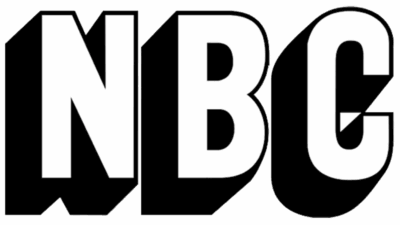 During the golden age of radio, NBC operated two distinct national networks: the Red Network and the Blue Network. The Chase and Sanborn Hour, featuring Edgar Bergen and Charlie McCarthy, aired on the NBC Red Network, which was the more commercially driven of the two. The Blue Network, meanwhile, focused more on news, cultural programming, and public service broadcasts.
During the golden age of radio, NBC operated two distinct national networks: the Red Network and the Blue Network. The Chase and Sanborn Hour, featuring Edgar Bergen and Charlie McCarthy, aired on the NBC Red Network, which was the more commercially driven of the two. The Blue Network, meanwhile, focused more on news, cultural programming, and public service broadcasts.
However, this dual-network system came under scrutiny. In 1942, following antitrust litigation, NBC was required to divest one of its networks. As a result:
• NBC Blue was sold off and became an independent entity.
• In 1945, it was officially renamed the American Broadcasting Company (ABC).
So while The Edgar Bergen/Charlie McCarthy Show was not part of the Blue Network, the broader NBC structure—and its eventual transformation—played a pivotal role in shaping American broadcasting. The show’s success on the Red Network helped define NBC’s dominance in entertainment programming during that era.
Conclusion: Echoes of Laughter
In the quiet hum of a Sunday evening, when the chores were done and the world outside grew still, The Chase and Sanborn Hour came alive. It wasn’t just a program—it was a ritual, a companion, a spark of joy in living rooms across America. For nearly two decades, it offered laughter, music, and the kind of intimacy that only radio could deliver. And though its microphones have long gone silent, its spirit endures—in recordings, in memory, and in the hearts of those who still believe in the magic of storytelling.
Edgar Bergen and Charlie McCarthy didn’t just entertain—they invited listeners into a world where imagination reigned. Their voices, along with those of countless stars who graced the broadcast, became part of the national soundscape. They made ventriloquism visible through sound, made celebrities feel like neighbors, and made Sunday nights something to look forward to.
Thanks to the USA Radio Museum’s remarkable archive, that world is not lost. It’s waiting—preserved in the crackle of vintage recordings, in the cadence of a well-timed joke, in the warmth of a melody that once filled the airwaves. By revisiting these broadcasts, we don’t just hear history—we feel it.
The Chase and Sanborn Hour was more than a show. It was a celebration of voice, of character, of connection. And as we listen again, we’re reminded that joy, once broadcast, never truly fades. It lingers—in echoes, in laughter, and in the timeless rhythm of a nation tuned in.
_____________________
A USARM Viewing Tip: On your PC? Mouse/click over each image for expanded views. On your mobile or tablet device? Finger-tap all the above images inside the post and stretch image across your device’s screen for LARGEST digitized view. Then click your brower’s back arrow to return to the featured post.

